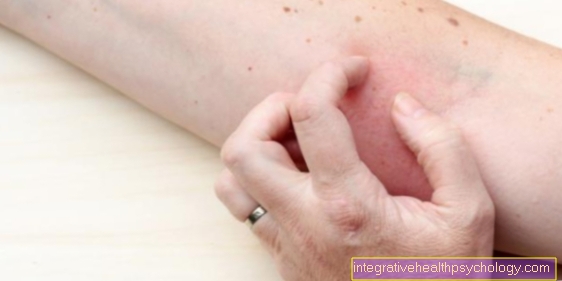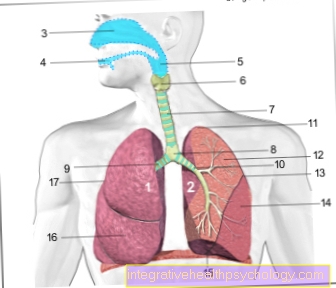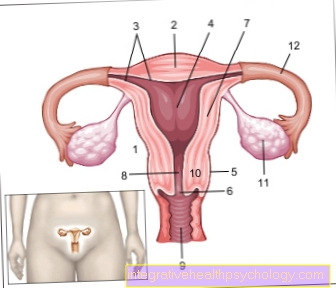Wrist pain
Synonyms
Radiocarpal joint
English: wrist pain
introduction
A variety of chronic and acute conditions can cause wrist pain. The pain indicated by the person affected can have different qualities depending on the cause.
From short-lasting, stabbing to long-lasting pain phenomena, everything is possible in the area of the wrist. When looking for the cause, the exact quality and location of the pain is an important point of reference. In addition, possible radiation, loss of sensitivity and the stress-dependent occurrence of abnormal sensations can provide an initial indication of the underlying disease.

Localization of the complaints
Outside pain
Pain on the outside of the wrist can have a number of causes. Ganglia, which can form due to excessive strain and lead to pain and restricted mobility, must be considered. Osteoarthritis, which occurs as a result of joint wear and tear, is a possible diagnosis and is particularly common in old age. Infections, e.g. after an open wound into which pathogens have entered are possible. If a shock or fall occurred before, it could also be a broken bone, which can be ruled out by means of an X-ray.
Read more on this topic at: Outer wrist pain
Pain inside
Carpal tunnel syndrome can cause pain on the inside of the wrist (toward the palm of the hand). This is a syndrome in which a nerve becomes trapped in what is known as the carpal tunnel. This nerve (nervus medianus) supplies the palm of the hand and especially the thumb, index and middle fingers with feeling and supplies the muscles. When the carpal tunnel becomes too narrow because the ligament structure thickens, symptoms appear. Carpal tunnel syndrome often affects older people and especially women. Affected people complain that the hand is falling asleep and becoming numb. Tingling and pain as well as loss of movement can also occur. Often this occurs at night and is so uncomfortable that patients wake up from it and have to move their hand. This can also occur temporarily during pregnancy, but usually disappears again.
Saddle joint arthrosis (rizarthrosis) on the thumb joint can also project pain onto the palm of the hand. Rarely, a ganglion can also form on the inside of the hand and cause pain there. Necrosis of the metacarpal bones, such as lunate malacia, which also causes pain, rarely occurs.
Causes of wrist pain
The causes of wrist pain can be many. In most cases, excessive or improper stress while writing or working leads to corresponding pain phenomena. Basically, the causes that lead to wrist pain can be divided into several groups.
Diseases are possible
- of the bony structures
- the tapes
- of tendons
- of the tendon sheaths
- and the muscles
Read more about the topic here
- Bruise wrist
- Ganglion on the finger
- Ganglion on the wrist
What diseases can be the cause?

The most common disease of the wrist is carpal tunnel syndrome. This results in pressure damage to the median nerve in the carpal tunnel (see above). Causes of a CTS (Carpal tunnel syndrome) cannot be seen in the majority of the disease. Possible causes are fractures near the wrist or rheumatic diseases.
Accompanying symptoms of carpal tunnel syndrome are loss of sensitivity in the area of the thumb, index and middle fingers on the palm of the hand. On the back of the hand, these abnormal sensations usually only occur on the phalanges of the fingers.
The frequent nocturnal occurrence of these complaints is a classic indication of carpal tunnel syndrome.
In addition to the abnormal sensations provoked by the presence of a carpal tunnel syndrome, wrist pain is often triggered by inflammatory processes in the area of the tendon sheaths.
Patients with tendinitis usually report severe, pulling pain on the affected tendon.
Further indications of inflammatory processes are
- Redness
- Overheating
- Swelling
- and loss of mobility of the affected wrist.
The so-called "Tendovaginitis stenosans de Quervain" (Synonym: housewife's thumb) is a special form of tendinitis. In this disease, the pain is localized on the wrist on the thumb side. It is not uncommon for the abnormal sensations to radiate into the forearm and can be exacerbated by stress.
The most common accident-related wrist pain is a broken wrist (distal radius fracture). In most cases, the spoke breaks a few centimeters above the wrist. In the case of a multiple fragment hernia, the joint surface can also be directly involved.
Pain from a scaphoid fracture is less common and occasionally not recognized.
Pain-related arthrosis of the wrist is relatively rare. The reason for this is the fact that the wrist does not have to carry any body weight.
Risk factors for wrist osteoarthritis (Radiocarpal arthrosis) are pre-existing wrist fractures, especially with direct joint involvement or diseases from the rheumatic group.
Often, pain is caused by osteoarthritis of the thumb saddle joint, a painful symptom of wear and tear when the thumb is moved and strained.
The enchondroma (a bone cyst), which consists of cartilage accumulations in the bone, is another cause of pain in the wrist. The conversion of bone to cartilage tissue leads to a painful increase in size over the long term, which results in a collapse or breakage of the affected bone can.
In the early stages, the patient suffers from complaints that mainly occur with heavy exertion and quickly subside if the patient postures gently. As the cartilage progresses, pain already occurs at rest.
Furthermore, frequent abnormal sensations in the wrist can often be traced back to anatomical malformations.
For example, an ulnar bone that is too short (ulna minus variant) can lead to pronounced pressure on the part of the wrist on the side of the spokes and in this way lead to pain in the wrist.
An ulna that is too long (ulna-plus variant), on the other hand, causes increased pressure on the wrist on the elbow side, with corresponding pain symptoms on the little finger side. Malformation-related pain in the wrist can usually only be remedied in the long term through surgical correction.
rheumatism
The term rheumatism combines various diseases of the whole body. These diseases have in common that the own immune system is directed against normal body parts and destroys them in the long term. In most cases, rheumatism on the wrist is colloquially referred to as "rheumatoid arthritis" which, in addition to numerous small joints in the body, can also affect the wrist. This leads to inflammation, pain, restricted mobility and stiffness of the joint. In the long term, this can also lead to painful cartilage wear, which irreversibly damages the joint.
Read about this too: How do you recognize rheumatism?
Other causes
Pain in the wrist is often caused by injuries or diseases of the bone or tendon system, but in the majority of those affected, such abnormal sensations can be traced back to simple excessive or incorrect strain.
Chronic overuse of the wrist is one of the main causes of pain. Above all, athletes and members of special professional groups (office workers, construction workers, etc.) are often affected.
In these cases, a constantly repeated irritation of the joint or the surrounding structures causes the smallest injuries (micro-injuries) in the tissue. The result is pain that increases steadily under stress and often persists even at rest.
In the therapy of this type of wrist pain, muscular stabilization and the avoidance of heavy strain play a major role. Rare causes of wrist pain are
- the gout (synonym: Hyperuricemia)
- and the pseudogout (synonym: Chondrocalcinosis).
In the case of gout, uric acid deposits in the wrist area. This primarily affects the metatarsophalangeal joint of the big toe, the metatarsophalangeal joint of the thumb, the ankle joints and the knee.
Gout develops in the wrist rather rarely.
Pseudogout with deposits of calcium crystals is also more likely to occur on the knee than on the wrist. In addition, various diseases, the cause of which is currently unclear, can lead to pain in the wrist. These diseases include:
-
Lunate Malacia
- Scaphoid necrosis
Wrist pain on exercise

The wrist is often affected by pain due to excessive strain. Various structures can form or change, which can be an expression of incorrect or excessive stress. For example, an excess leg (ganglion) can develop, which usually forms on the back of the hand at the transition from forearm to wrist. A ganglion is a protrusion of a joint membrane or tendon sheath that surrounds the tendons so that they slide well. If this bulge thickens or water becomes trapped in it, a palpable knot can form on the wrist that hinders movement. Patients report pain in the wrist, particularly when they are exerted, such as push-ups.
Tendonitis can also cause pain on exercise. It mostly arises from a lot of writing, typing or other activities by hand. The tendon sheath surrounding the tendon thickens and is inflamed. The tendinitis is often accompanied by redness, swelling and pain in the wrist.
Other diseases can also affect the wrist and are particularly noticeable when exercising. These include above all rheumatic diseases. Psoriasis can also be associated with joint problems (psoriatic arthritis) and should be clarified.
Wrist arthrosis (radiocarpal arthrosis) must also be considered. This is a wear and tear on the wrist cartilage and can occur in several ways. Sometimes the cause is not known, but it often arises secondarily from another disease or after fractures.
Pain when twisting
The most common cause of wrist pain when twisting is tendinitis (tendovaginitis). This thickens the tendon sheath that surrounds a tendon. Often this occurs after a period of frequently repetitive motion sequences. The tendon of the muscle, which is particularly stressed during this movement, rubs back and forth in its tendon sheath and becomes inflamed. This can be triggered by screwing in screws with a screwdriver, or by a lot of writing and typing. Those affected often describe pulling pains that radiate into the forearm. You can also hear a click when turning. Tendonitis is usually treated by immobilization and relief, if necessary with cortisone injections on the tendon or, rarely, by an operation that splits the tendon sheath.
Pain after a fall
After falling on the wrist, it may be bruised or broken. Since both can be accompanied by severe swelling, the differentiation by means of clinical tests is often not sufficient. To find out for sure, an x-ray of the wrist is often necessary. If there is a bruise or a strain, no bone fracture can be detected on the X-ray. In this case, the ligaments and tendons in particular were strained by the fall, but usually heal again after a few weeks without consequences.
Also read more on the topic: Bruise from the finger or Torn ligament on the wrist
Different bones can be affected when a fracture occurs. Often the spoke (the radius) breaks, i.e. the forearm bone that pulls towards the wrist on the side of the thumb and forms the wrist with the wrist bones. This so-called distal radius fracture is one of the most common breaks. This bone fracture also often affects women who suffer from bone softening (osteoporosis). The diagnosis becomes likely if a wrist misalignment is visible or a step in the bone can be felt. Severe swelling and pain also indicate this diagnosis. The ulna is less often broken, i.e. the forearm bone that pulls towards the wrist on the side of the little finger and forms the wrist on this side with the wrist bones. The metacarpal bones can also break. Sometimes the scaphoid bone (os scaphoideum) breaks in a fall, here it is particularly important to keep the arm still for a long time so that the scaphoid bone heals completely again.
Read more on the topic: Ligament injury on the wrist
Pain when propping up
Pain in the wrist, which is aggravated when propping up, is very typical with irritation in the joint, as well as after injuries to the bone, ligament and cartilage structures in the wrist. Numerous movements, injuries, sports and anatomical features can cause damage and pain to the wrist over time. The cartilage between the ulna and the carpal bones, which is called the "triangular disc", is very often involved. This area of the joint can be damaged by years of wear and tear but also by acute events. When propping up, this cartilage is particularly heavily loaded.
By propping up, as well as by vibrations in sports or supporting the hands in a fall, damage to the wrist cartilage can be triggered and exacerbated. A fall that is caught with the hands can often lead to cartilage damage and even fractures of the forearm and carpal bones. Supporting the hands accordingly provokes pre-existing pain through the increased pressure on bony and cartilaginous joint components.
Pain without swelling
Swelling is an increase in the accumulation of fluid in the tissue. A swelling on the wrist may be purulent, bloody, or clear. In most cases this is due to an acute injury to cartilage, bones or ligaments, inflammation of joint structures or a chronic irritation of the tendons and synovial membranes.
However, all acute or chronic changes to the wrist can proceed without swelling. The swelling is only an accompanying symptom which can occur as a reaction to diseases of the joint. But even without swelling, ligaments and cartilage tears or bones broken after an acute event. The absence of severe swelling even enables faster healing in the case of chronic irritation, strains, inflammations and injuries.
The swelling itself causes additional pain. With suitable acute therapy, swelling after injuries can even be reduced and prevented. To do this, the joint should be cooled, compressed, protected and stored high.
On the thumb
Pain in the thumb can also occur after injuries and degeneration of the cartilage and bone. The most common cause of wrist pain in the thumb, on the other hand, is tendinitis in this area. This occurs without causal pathogens as a result of a permanent irritation. The thumb is particularly often affected by tendinitis. Due to its exposed anatomical position and its important function when gripping, the thumb is particularly exposed to stress. Tendonitis often begins at the wrist level and continues on the extensor side of the thumb and on the forearm.
Please also read our topics:
- Tendinitis on the wrist
- Tendinitis in the thumb
Wrist pain with numb fingers
Wrist pain associated with numb fingers is an important indicator of "carpal tunnel syndrome". In the middle area of the wrist, important tendons and muscles pull together with the median nerve through the carpal tunnel from the forearm into the hand. The carpal tunnel is an anatomically very narrow space. Even light pressure on the inside of the wrist can pinch the nerve and cause tingling, numbness, muscle weakness and paralysis in the fingers. If this anatomical tightness increases, permanent pain and numbness can occur. In many cases, the carpal tunnel syndrome has to be treated surgically so that the pain does not suffer any lasting damage.
Illustration wrist pain

A - Chronic causes
B - Acute causes
- Rheumatoid Arthritis (RA) -
inflammatory disease
the joints - Arthrosis -
Joint wear - Carpal Tunnel Syndrome (KTS) -
constriction of the median nerve - Ganglion (upper leg) -
benign tumor formation - Torn ligament -
Rupture of a joint ligament - Finger dislocation -
Dislocated finger - Broken finger (finger fracture) -
a - distal
b - medial
c - promaximal - Wrist hernias
(here scaphoid fracture)
I - I - metacarpal joint -
Articulatio metacarpophalangea
II - II - Carpal-metacarpal joints -
Articulationes carpometacarpales
III - III - Lower wrist -
(distal)
Articulatio mediocarpalis
IV - IV - Upper wrist -
(proximal)
Articulatio radiocarpalis
You can find an overview of all Dr-Gumpert images at: medical illustrations
diagnosis
If pain occurs frequently, the wrist should be removed from medical side with regard to the present Swelling, Deformations and the development of force when gripping are examined.
In addition, the range of motion must be assessed extensively. Above all, the exact localization and intensity of the pain in the wrist can provide an initial indication of the causal disease.
Making a X-ray from the wrist provides information about whether the bony structures in the area of the wrist are impaired (e.g. by a fracture), whether wear in the wrist (wrist arthrosis) or a Arthritis (wrist inflammation) present.
Does the V.a. a hidden fracture (occult fracture of the wrist, i.e. a broken wrist that cannot be seen on an X-ray) can be a Computed Tomography (abbreviated to: CT). The improved resolution of the CT makes hidden wrist fractures visible.
Does the V.a. to a soft tissue injury, i.e. injury to Ribbons, Traingular disc or cartilage is the most valuable examination of the wrist MRI. The MRI can also reliably detect inflammation of the tendons or wrist, as well as the bone. For injuries to the bones, however, the MRI of the wrist is clearly inferior to the CT, as the resolution of the MRI is lower.
You can find out more about this topic under our topic: MRI of the wrist
Using a joint specimen (synonym: Arthroscopy) a look inside the wrist can be taken. An endoscopy of the wrist is a rare indication and is used if the Discus triangularis or free joint bodies considered in the wrist.
In the event of a loss of sensitivity, the implementation of a neurological nerve tests often sense.
Which doctor treats wrist pain?
In almost all cases, wrist pain is due to acute or chronic changes in the bones, ligaments, cartilage and other joint structures. An orthopedic surgeon should be consulted for these musculoskeletal disorders. Inflammation and degenerative diseases can be conservatively accompanied and treated by an orthopedic surgeon.
In many cases, however, acute injuries require surgical treatment to sew or screw damaged bones and cartilage. This treatment can be performed by a trauma surgeon, orthopedic surgeon, or plastic surgeon. A particular medical specialization lies in hand surgery, which is also made up of these surgical disciplines. Hand surgeons have special expertise in the treatment of the small and filigree structures on the wrist.
Appointment with a hand specialist?
I would be happy to advise you!
Who am I?
My name is dr. Nicolas Gumpert. I am a specialist in orthopedics and the founder of .
Various television programs and print media report regularly about my work. On HR television you can see me every 6 weeks live on "Hallo Hessen".
But now enough is indicated ;-)
In order to be able to treat successfully in orthopedics, a thorough examination, diagnosis and a medical history are required.
In our very economic world in particular, there is too little time to thoroughly grasp the complex diseases of orthopedics and thus initiate targeted treatment.
I don't want to join the ranks of "quick knife pullers".
The aim of any treatment is treatment without surgery.
Which therapy achieves the best results in the long term can only be determined after looking at all of the information (Examination, X-ray, ultrasound, MRI, etc.) be assessed.
You can find me at:
- Lumedis - orthopedics
Kaiserstrasse 14
60311 Frankfurt am Main
Directly to the online appointment arrangement
Unfortunately, appointments can only be made with private health insurers. I ask for understanding!
Further information about myself can be found at Lumedis - Dr. Nicolas Gumpert
Therapy for wrist pain

Treatment of wrist pain is primarily based on the underlying disease. As a rule, the pain phenomena that occur can be treated quite well, regardless of the underlying cause.
In general, wrist pain, whether caused by excessive strain or a fall, should be treated with immobilization and cooling. Since the wrist is used a lot in everyday life, it is advisable to put on a bandage or a splint to really protect it from stress. You can also use taping to enable certain movements and prevent others. A plaster splint is rarely used to keep the wrist really still. To relieve the pain, painkillers can be taken, which also have a decongestant effect. This also reduces the inflammatory reaction in the wrist. This can be done with tablets (such as ibuprofen), or locally, for example with a diclofenac (Voltaren) ointment bandage.
If there is swelling, the wrist should be held up so that the blood can flow out better. You can also place the affected hand higher than the rest of the body on some pillows while sleeping.
If the cause is known, specific therapeutic measures can be applied. In the case of a ganglion, for example, a puncture can help drain the fluid that has collected in the ganglion sac. Surgical removal can also be considered.
In the case of tendinitis, the hand should be kept particularly still and the triggering movement reduced to a minimum. If this is not enough, a cortisone injection can also bring about an improvement. An operation that involves splitting the tendon sheath is also rarely necessary.
In the case of bone fractures, surgical therapy is often necessary so that the fracture heals completely. If this is not done, malalignment can result and lead to long-term pain. In the case of well-standing, smooth fractures, immobilization using a plaster of paris may be sufficient.
For rheumatic diseases, experienced rheumatologists have to weigh up the therapeutic options. Medicinal measures are often required here.
If the wound is infected, antibiotics may be necessary to prevent the infection from spreading.
In conclusion, in most cases, regular application of anti-inflammatory ointments is enough to achieve effective pain relief.
In addition, consistently wearing a support bandage can alleviate wrist pain.
Various medications can be used for serious underlying illnesses.
The attending physician will inform the patient concerned about the necessary / possible treatment measures after the diagnosis.
Taping
An alternative to bandages, splints and plaster of paris is the so-called taping / taping. This can also be used to stabilize the wrist and promises better wearing comfort. By guiding the ligaments, it can continue to allow and support certain movements, while other movements are specifically slowed down. As a result, the hand can be moved and used even better overall. In addition, it is much lighter than a plaster cast. But tapes can also be used prophylactically. Many professional athletes use them to prevent injuries and to support heavily stressed tendons, joints and muscles.Boxers and other martial artists also tape their wrists to keep them stable when the force is applied. Tapes should be put on by experienced therapists in order to achieve sufficient stability in the joint. However, it should be considered which measure is more suitable for immobilization, since a tape cannot of course be as stable as a plaster splint. Depending on the objective, however, it is a good alternative.
Another type of taping is what is known as kinesio tape. This differs from classic taping as the tapes are elastic and contribute less to stability and guidance (you can usually recognize these tapes by their bright colors). The effect of these tapes is controversial.
Read more on the topic: Tap your wrist
Anatomy on the subject
X-ray wrist

- Scaphoid bone (scaphoid bone)
- Moon bone (os lunatum)
- Pea bone (os pisiforme)
- Triangular bone (os triquetum)
- Hook bone (os hamatum)
- Head bone (os capitatum)
- small polygonal bone (os trapezoidum)
- large polygonal bone (os trapezium)
Figure wrist

Outline of the hand
(Joint lines green)
I - Upper (proximal) wrist
II - Lower (distal) wrist
III - carpal - metacarpal
Joints
IV - metacarpal joint
V - median joint
(missing on thumb)
VI - interphalangeal joint
VII - thumb joint
- Distal phalanx -
Phalanx distalis - Phalanx -
Phalanx media - Phalanx -
phalanx proximalis - Metacarpal bones - Metacarpals
- Trapezoidal leg - Trapezium
- Trapezoid leg - Trapezoid bone
- Head leg - Os capitatum
- Hook leg - Hamate bone
- Scaphoid bone of the hand -
Scaphoid bone - Moonbone - Lunate bone
- Triangular leg - Os triquetrum
- Pea bone - Os pisiform
- Sesame bone - Os sesamoideum
- Cubit - Ulna
- Spoke - radius
You can find an overview of all Dr-Gumpert images at: medical illustrations





























